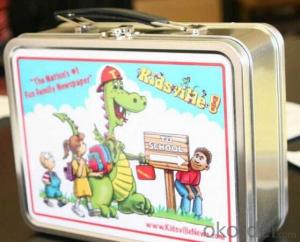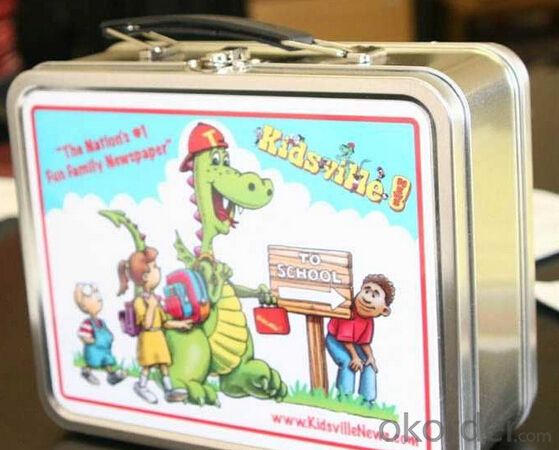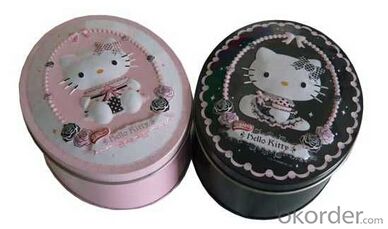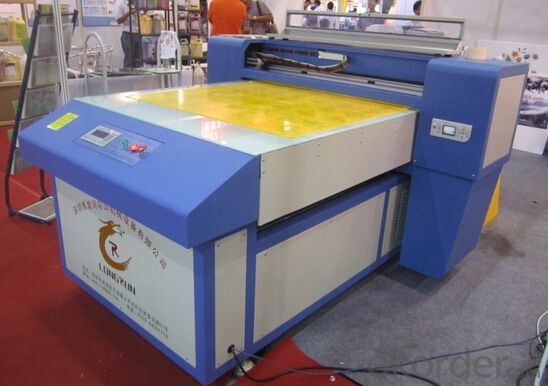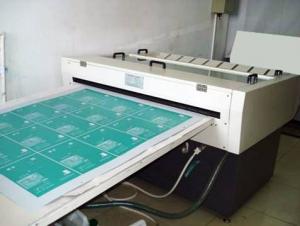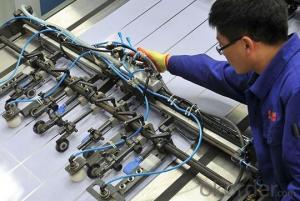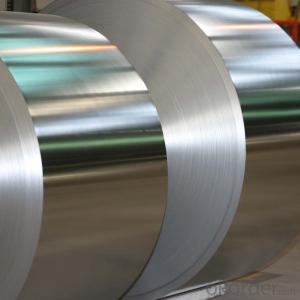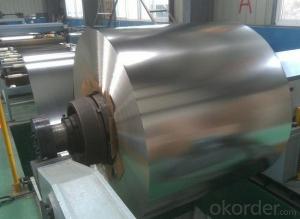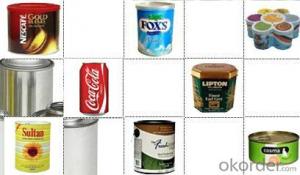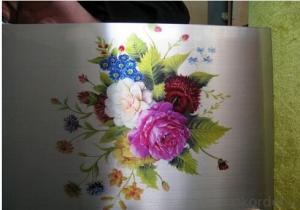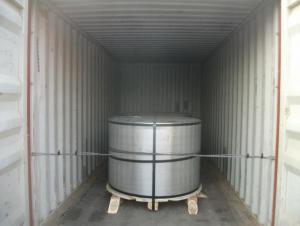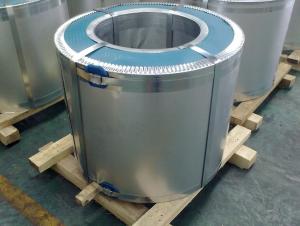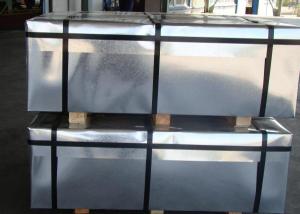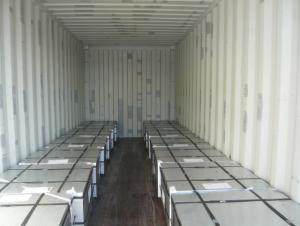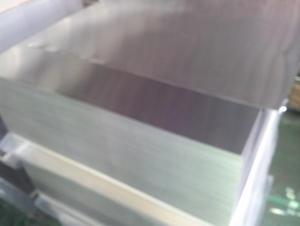Printed Tinplate Sheet for Metal Cans Packaging
- Loading Port:
- China main port
- Payment Terms:
- TT OR LC
- Min Order Qty:
- 25 m.t.
- Supply Capability:
- 30000 m.t./month
OKorder Service Pledge
OKorder Financial Service
You Might Also Like
Printed and Coated Tinplate for Metal Printing
1. Product Description:
Tinplate and TFS are widely used for making all types of containers such as artistic cans, tea cans, painting cans, chemical package cans and metal printing etc. Its applications are not limited to containers; recently, they have also been used for making electrical machinery parts and many other products.
2. Product Features:
Fully Automatic
Beautiful Appearance
Excellent Paintability & Printability
Excellent Formability & Strength
Excellent Corrosion Resistance
Excellent Solderability & Weldability
3. Product Parameters:
Technical standard | JISG3315 and GB/T24180 - 2009 (BS EN 10202:1990) |
Steel Type | MR / SPCC |
Thickness | From 0.15mm to 0.50mm (Tolerance +/- 0.01mm) |
Width | Normally 600-1050mm (Tolerance +3/-0 mm) |
Coating | Total chromium min 30mg/m2 max 140mg/m2 |
Temper & Annealing | T1-T5, DR7-8, TS230-TH435, T49-T65(+/- 4) |
Surface Treatment | Bright & Fine Stone & Stone & Silver & Matt |
Payment terms | Letter of Credit (L/C), Telegraphic transfer (T/T) |
Price terms | CFR & CIF price term |
Delivery time | Within 60 days after received L/C or T/T down payment |
Packing | High quality shipping packing which contains thin plastic film, rust-proof paper, metal cover, metal angles and strap sand pallet. |
Minimum order Quantity(MOQ) | 25 metric tons (1X 20'' container) |
4. FAQ:
Q1: What is your delivery time?
A: Generally, the delivery time is 70 days after receive the deposit, special specification may take more time.
Q2: What is the payment term?
A: We accept both T/T and L/C. Most customers pay by T/T.
Q3: What kind of after-sevices do you provide?
A: If it is not big problem, we can solve it by emails, phone etc. Or we went to your company to slove it in person.
5. Product Pictures:
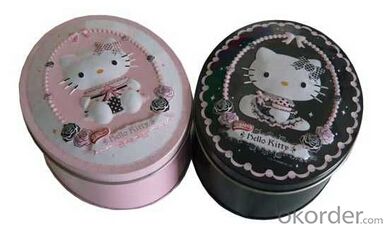
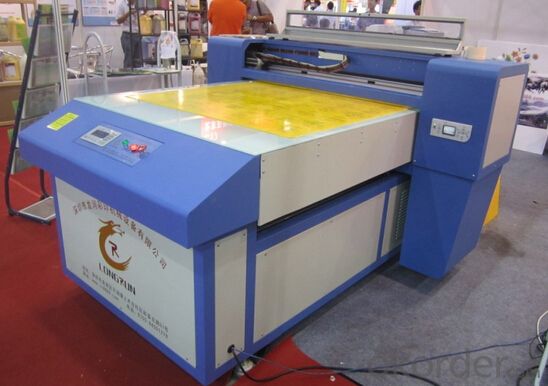
- Q: What are the different methods of joining tinplate components together?
- There are several methods for joining tinplate components together. Some common techniques include soldering, spot welding, adhesive bonding, and mechanical fastening. Each method has its advantages and is chosen based on factors such as the complexity of the assembly, desired strength and durability, and cost considerations.
- Q: How does tinplate perform in terms of resistance to chemical agents?
- Tinplate demonstrates good resistance to chemical agents due to its protective tin coating, which acts as a barrier against corrosion and interaction with various substances.
- Q: What are the different types of tinplate containers available?
- There are several different types of tinplate containers available, including cans, tins, boxes, and drums. These containers can vary in size, shape, and functionality, and are commonly used for packaging food, beverages, chemicals, and other products.
- Q: What are the printing options for tinplate?
- The printing options for tinplate include lithography, screen printing, and digital printing.
- Q: How does tinplate affect the overall product shelf appeal?
- Tinplate can significantly enhance the overall product shelf appeal due to its attractive and glossy appearance. The metallic finish of tinplate gives products a premium and luxurious look, making them stand out among competitors on store shelves. Additionally, tinplate's durability and ability to maintain its shape and color over time improve the product's presentation, creating a positive impression on consumers.
- Q: Can tinplate be embossed?
- Yes, tinplate can be embossed.
- Q: Can tinplate be used for furniture?
- Yes, tinplate can be used for furniture. It is a versatile material that can be shaped and molded into various furniture components, such as decorative panels, legs, or frames. Tinplate's durability, corrosion resistance, and aesthetic appeal make it suitable for furniture applications, particularly in industrial or vintage-inspired designs.
- Q: How is tinplate tested for quality control?
- Tinplate is tested for quality control through various methods including visual inspection, measurement of coating thickness, adhesion testing, and corrosion resistance testing.
- Q: What are the common safety features for tinplate packaging?
- Common safety features for tinplate packaging include: 1. Tamper-evident seals: These seals are designed to show if a product has been tampered with before opening, ensuring the integrity of the contents. 2. Child-resistant closures: These are mechanisms that require a specific combination of motions or strength to open, preventing young children from accessing potentially harmful substances. 3. Sharp-edge protection: Tinplate packaging is designed to have smooth edges, minimizing the risk of injury during handling and opening. 4. Chemical resistance: Tinplate packaging is often coated with a protective layer to ensure it is resistant to corrosion and chemical reactions, preventing contamination of the product inside. 5. Reclosability: Some tinplate packaging features resealable lids or closures, allowing for multiple uses and maintaining product freshness. 6. UV protection: Tinplate packaging can also be designed to provide UV protection, preventing light-sensitive products from deteriorating due to exposure to sunlight. 7. Stability: Tinplate packaging is typically designed with a sturdy structure, ensuring it can withstand transportation and handling without easily denting or breaking. These safety features aim to protect consumers, prevent accidents, maintain product quality, and comply with regulations in various industries.
- Q: Can tinplate be used for military applications?
- Yes, tinplate can be used for military applications. It is a versatile material that offers several benefits such as corrosion resistance, durability, and ease of fabrication. Tinplate can be used for various military applications including ammunition packaging, shelter construction, and equipment protection.
Send your message to us
Printed Tinplate Sheet for Metal Cans Packaging
- Loading Port:
- China main port
- Payment Terms:
- TT OR LC
- Min Order Qty:
- 25 m.t.
- Supply Capability:
- 30000 m.t./month
OKorder Service Pledge
OKorder Financial Service
Similar products
Hot products
Hot Searches
Related keywords
